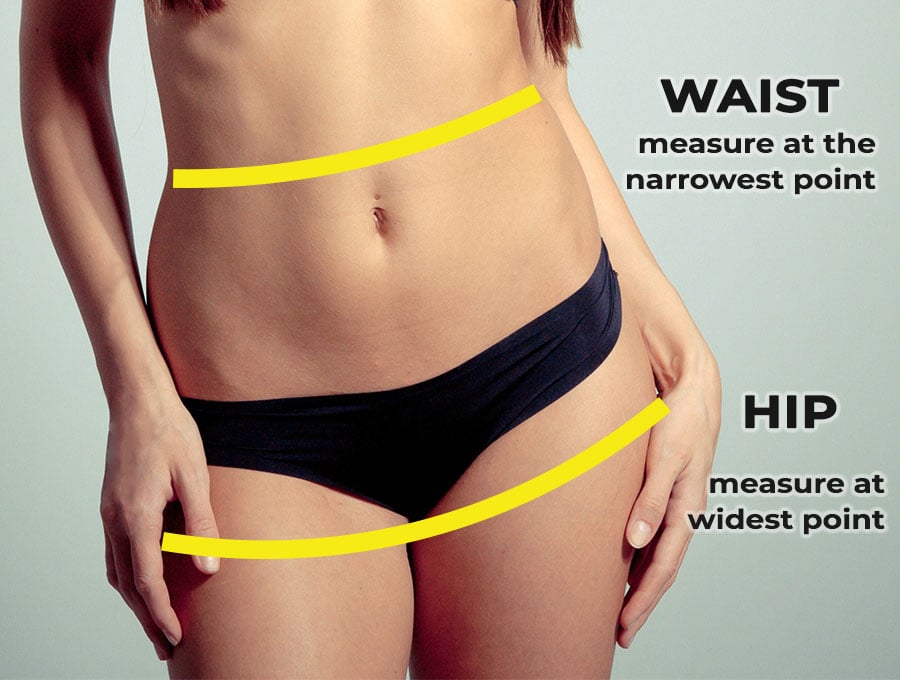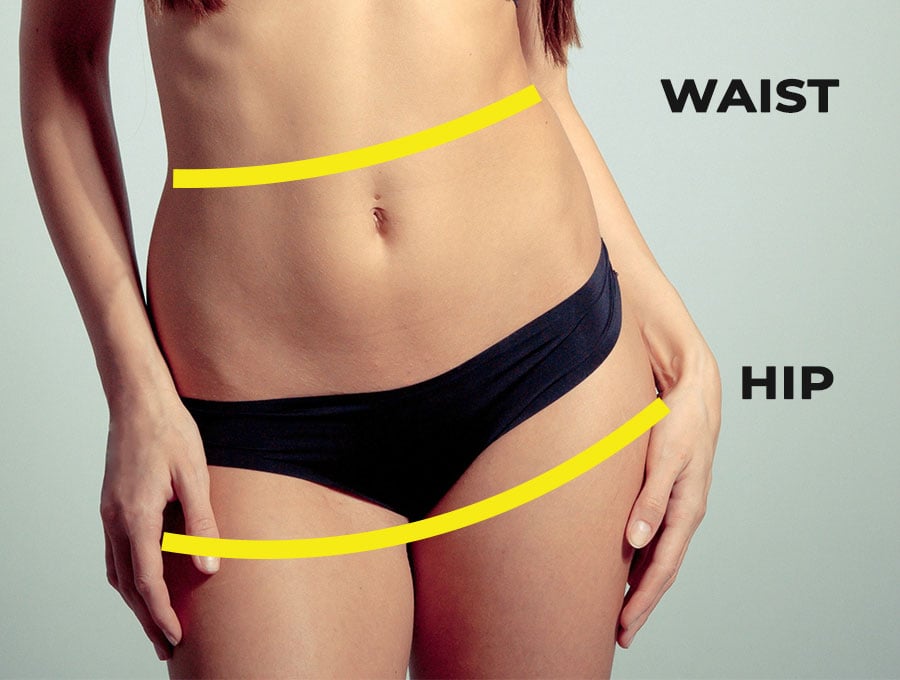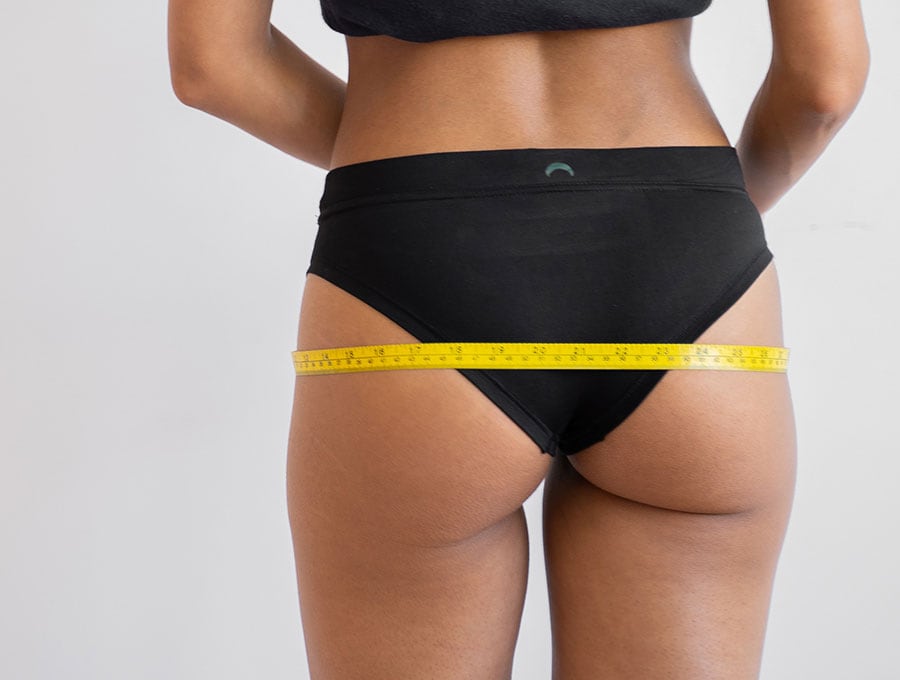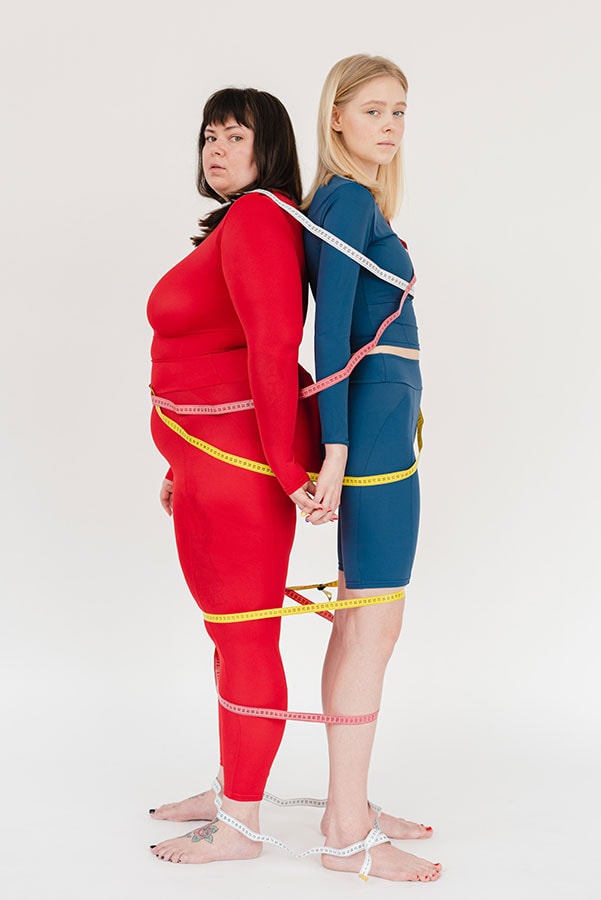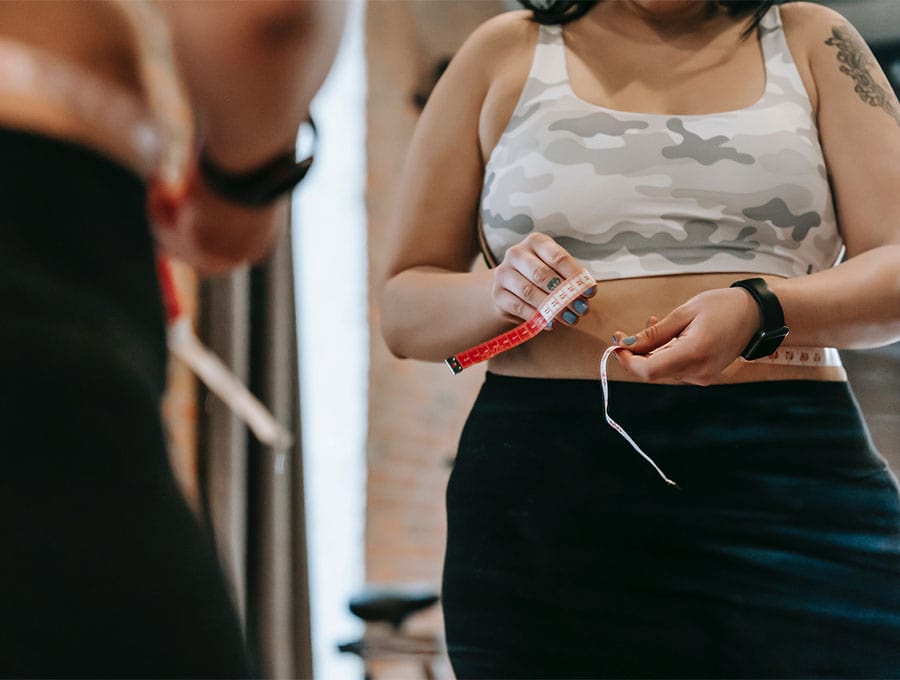Waist vs Hip: What’s the Difference, How to Measure and More
In the world of sewing and fashion, understanding the differences between waist and hip measurements is essential for sewists looking to create garments that not only fit well, but also accentuate the wearer’s natural shape. These two key measurements are often used together in a ratio to determine how a garment will look on a person, affecting the overall silhouette and emphasizing certain areas of the body.
Measuring the waist and hips is quite simple: to find the waist measurement, locate the narrowest part of the torso, which typically falls around the belly button, and wrap a flexible tape measure around that point. The hip measurement is found by locating the widest part of the lower body, usually around the buttocks, and measuring the circumference. By comparing these numbers, sewists can use the waist-to-hip ratio to make informed decisions on how to tailor garments for an attractive fit.
When it comes to utilizing the waist-to-hip ratio for creating a flattering garment, sewists should carefully consider the cut and style of the piece. For example, a fitted waist with a more generous hip area might result in an A-line skirt that gracefully highlights the waistline, while a balanced ratio can lend itself to a more form-fitting silhouette that accentuates the natural curves of the body. Ultimately, recognizing these dimensions and adjusting patterns accordingly can empower sewists to create uniquely beautiful and flattering garments for any body type.
Table of Contents
- 1 Hip vs Waist Measurement: How & Where to Measure Correctly
- 2 Is Hip The Same as Waist?
- 3 How to Measure Waist
- 4 How to Measure Hips
- 5 How to Calculate Waist-to-Hip Ratio
- 6 What Is the Most Attractive Waist to Hip?
- 7 Should I Go by Hip or Waist Measurement?
- 8 What Are Good Hip and Waist Measurements?
- 9 Conclusion
Hip vs Waist Measurement: How & Where to Measure Correctly
For sewists, understanding the difference between waist and hip measurements is crucial in creating garments that fit and flatter the body. Getting these measurements right is the key to ensuring that your clothing projects look attractive and feel comfortable.
To start, let’s clarify the difference between waist and hip measurements. The waist is the narrower part of the torso, typically above the navel and below the ribcage. In contrast, the hip measurement is taken at the fullest, widest part of the lower body, including the buttocks.
To measure the waist and hips accurately, sewists should use a flexible measuring tape, ensuring that it is placed parallel to the floor and wrapped around the body without any slack. Having precise measurements allows for better pattern adjustments and customized fitting.
When measuring the waist, have the person being measured stand up straight and find their natural waistline by bending to one side to locate the natural crease. Place the measuring tape around this area, ensuring it is parallel to the floor and snug, but not too tight. Keep your fingers between the tape and the body to avoid compressing the skin.
For the hip measurement, have the person stand with their feet together, and locate the widest part of the hips and buttocks. Wrap the tape measure around this area, ensuring that it is parallel to the floor and snug against the body.
Comparing the waist and hip measurements allows you to calculate the waist-to-hip ratio, which is helpful in creating garments with an attractive fit. A table can help you visualize the ideal ratios for different body shapes:
| Body Shape | Ideal Waist-to-Hip Ratio |
|---|---|
| Hourglass | 0.7 |
| Pear | 0.8 |
| Rectangle | 0.9 |
With these ratios in mind, you can create garments that accentuate the natural curves and draw attention to the desired areas. For example, a sewist might add more volume to the hips of a garment to create a more pronounced hourglass shape.
Taking accurate waist and hip measurements is an essential skill for sewists. Mastering these techniques will enable you to create garments that fit and flatter a variety of body shapes, enhancing your sewing projects and making your creations even more enjoyable to wear.
Is Hip The Same as Waist?
When it comes to sewing and understanding body measurements, it’s important for sewists to differentiate between waist and hip measurements. Although these two terms are sometimes used interchangeably, they refer to different parts of the body and have distinct implications in garment design and fit.
The waist is the narrowest part of the torso, located above the belly button and below the ribcage. To measure the waist, a sewist can use a flexible measuring tape, wrapping it around the natural indentation or the smallest circumference of the waist area. Ensuring the tape is level and not too tight or loose is crucial for accurate measurements.
On the other hand, the hip refers to the widest part of the lower body, encompassing the buttocks and upper thighs. To measure the hip, the tape should be placed around the fullest part of the lower body, usually at the level of the hip bones. Again, maintaining level and snug—but not too tight—placement of the tape is key.
Understanding the difference between waist and hip measurements is essential for sewists because the waist-to-hip ratio plays a significant role in creating flattering garments. Knowing these measurements allows sewists to determine the most appealing silhouette for an individual’s body type. For example, a garment emphasizing a smaller waist-to-hip ratio may create an hourglass figure, while a garment with more equal waist and hip measurements may give the appearance of a more balanced or rectangular shape.
When designing and sewing clothes, it’s essential for sewists to:
- Accurately measure the waist and hip circumference
- Consider the waist-to-hip ratio when selecting garment styles
- Adjust patterns and designs to accommodate unique body proportions
How to Measure Waist
Measuring your waist accurately is crucial for sewists, as it plays a significant role in ensuring proper fit and enhancing the attractiveness of the garments you create. Follow these steps to measure your waist correctly and make the most of the waist-to-hip ratio in your sewing projects.
First, locate the natural waistline, which is the narrowest part of the torso. Typically, it sits above the belly button and below the ribcage. If you’re having trouble finding it, bend to one side and note the area where your torso creases. That’s your natural waistline.
Next, stand in front of a mirror and remove any bulky clothing. Hold a soft measuring tape parallel to the floor and wrap it around your natural waistline. Be sure not to pull the tape too tight or let it sag. It should sit comfortably against your skin without any compression.
- Breathing normally, stand straight, and ensure that the tape is evenly wrapped
- Take multiple measurements to confirm the accuracy
- Note down your waist measurement for future reference
Understanding your waist-to-hip ratio can help you create garments that flatter your body type while making you feel comfortable and confident. To calculate this ratio, measure your hips at their widest point and divide your waist measurement by your hip measurement. For example, if your waist measures 28 inches and your hips measure 38 inches, your waist-to-hip ratio is 0.74.
Sewists can use this ratio to determine the ideal fit for various clothing items, such as skirts, dresses, and pants. By creating garments that accentuate the waist and hips, you can achieve a visually pleasing and well-fitted look.
How to Measure Hips
When creating garments for themselves or others, sewists need to take accurate hip measurements. This ensures a flattering and well-fitted end result. Here’s how to measure hips accurately and effectively.
First, gather the necessary materials. A flexible measuring tape and a mirror are essential tools for this task. Wearing form-fitting clothes or undergarments is also recommended to avoid inaccurate measurements due to bulky fabrics.
Stand up straight with your feet close together in front of a mirror to ensure proper posture during measurement. Locate the widest part of your hips, which is usually around the buttocks area. Hold the end of the measuring tape at this point and wrap it around the hips, making sure it remains parallel to the ground. Keep the tape snug, but not too tight, to prevent indentation or discomfort.
Once the measuring tape is in place, take note of the number where the tape overlaps. This measurement is the hip circumference. Write it down and use it alongside waist measurements to determine the waist-to-hip ratio. To calculate the ratio, divide the waist measurement by the hip measurement:
Waist-to-Hip Ratio = Waist Measurement / Hip MeasurementUnderstanding the waist-to-hip ratio is valuable for sewists as it can help create garments that emphasize or downplay certain areas, achieving a more flattering silhouette. For example, an A-line skirt, which flares out from the waist, can create a balanced look for someone with a higher waist-to-hip ratio.
How to Calculate Waist-to-Hip Ratio
Calculating the waist-to-hip ratio is essential for sewists to create well-fitting garments. As an important aspect of designing clothes, understanding and determining the waist-to-hip ratio will help sewists match the garments to the wearer’s body shape, making them more attractive and comfortable.
Follow these simple steps to measure and calculate the waist-to-hip ratio:
- Stand in a relaxed posture and breathe out gently.
- Use a measuring tape to measure the narrowest part of the waist, just above the belly button.
- Measure the widest part of the hips, usually around the buttocks.
- Divide the waist measurement by the hip measurement to obtain the waist-to-hip ratio.
For example, if a person has a waist measurement of 28 inches and a hip measurement of 40 inches, the waist-to-hip ratio would be 0.7 (28/40).
This ratio can be used by sewists to adjust patterns and draft their own designs, ensuring a better fit and enhancing the wearer’s silhouette. It also helps sewists understand different body types and how to create garment styles that suit them best.
When designing clothes, sewists can take the waist-to-hip ratio into consideration by:
- Emphasizing the waistline with tailored cuts and cinching details.
- Choosing the right skirt or pant styles that flatter the hip area.
- Opting for patterns designed for specific waist-to-hip ratios.
By using the waist-to-hip ratio as a guide, sewists can create stunning garments that not only fit well but also enhance the look and feel of the wearer.
- For an hourglass figure, sewists might choose to accentuate the waist with a belt or fitted bodice.
- For those with a more rectangular shape, sewists can add volume to the hips with a peplum or A-line skirt.
What Is the Most Attractive Waist to Hip?
When designing clothes for a flattering silhouette, the waist to hip ratio plays a crucial role in enhancing the attractiveness of a garment. For sewists, understanding this ratio and how to measure it will assist in creating beautiful and well-fitted clothing.
The waist to hip ratio evaluates the proportion between the waist circumference and the hip circumference. It is calculated using the following formula: waist measurement divided by hip measurement. In the sewing world, the golden ratio of 0.7 for women and 0.9 for men is widely regarded as the most attractive waist to hip, although it can vary based on culture and personal preference.
To ensure accurate results, use a soft measuring tape when taking measurements. Measure the waist circumference at the narrowest point, which is usually around the navel, while the hip circumference should be measured at the widest part of the buttocks.
Applying the waist to hip ratio effectively while designing clothes requires a good understanding of patterns and adjustments. Several techniques come in handy:
- Use wide belts or waistbands to accentuate the waistline.
- Make use of dart manipulation to create a flattering shape.
- Choose the right type of fabric for better drape and body contouring.
- Opt for patterns with waist shaping elements, such as tapered skirts, dresses, or empire waistlines.
Employing the waist to hip ratio concept can greatly improve the appearance of garments created by sewists. By utilizing accurate measurements and implementing such techniques, flattering and attractive clothing can be crafted to suit various body types.
Should I Go by Hip or Waist Measurement?
When it comes to sewing and fitting garments, deciding whether to go by hip or waist measurements can be a challenge. Both measurements are important, but their significance depends on the type of clothing and desired fit.
For sewists, understanding how to take accurate waist and hip measurements is crucial. To measure your waist, wrap a measuring tape around the narrowest part of your torso, slightly above your belly button. For your hips, wrap the tape around the fullest part of your lower body, typically where your buttocks protrude the most. Ensuring these measurements are precise ensures well-fitted and flattering garments.
Your waist to hip ratio (WHR) can also be a helpful tool in determining the best fit. This ratio is calculated by dividing your waist measurement by your hip measurement. A lower WHR usually signifies a more hourglass-like figure, whereas a higher WHR suggests a more rectangular shape. This information can influence your garment selection and help create attractive silhouettes based on your body type.
For some garments, like skirts and pants, hip measurements are crucial as they account for the most substantial region of the garment. Incorrect hip measurements can lead to ill-fitting clothes and discomfort. In these cases, prioritizing hip measurements is advisable.
On the other hand, waist measurements are typically more important for dresses and fitted tops, where the garment is meant to follow the contours of your upper body. This allows for a more flattering and comfortable fit around your torso.
In conclusion, focusing on hip or waist measurements depends on the specific garment and the desired fit. For sewists, mastering the art of accurate measurements and applying them to different clothing types can result in stunning and well-fitting creations.
What Are Good Hip and Waist Measurements?
For sewists, understanding good hip and waist measurements is crucial in creating perfect-fitting garments for themselves or their clients. Measurements form the foundation of well-tailored clothing and greatly influence the final appeal of a piece.
To start, one must know how to precisely measure their hips and waist:
- Waist: Find the narrowest part of the torso, typically an inch or so above the navel. Wrap a measuring tape around this area and note the measurement.
- Hips: Measure the fullest part of the hips, ensuring the measuring tape is kept level all around the body.
Once measurements are taken, the Waist-to-Hip Ratio (WHR) can be calculated. This is an important factor in flattering clothing design:
WHR = (Waist Measurement) / (Hip Measurement)
A WHR below 0.8 is typically considered attractive for women, while below 0.9 is attractive for men. By using WHR as a guide, sewists can create designs that best complement the wearer’s body proportions.
While there are varying opinions on what constitutes ideal hip and waist measurements, it’s essential for sewists to remember that bodies come in different shapes and sizes, and the priority should be on creating garments that enhance one’s unique aesthetic. Garments should be comfortable, well-fitting, and make the wearer feel confident in their appearance.
Conclusion
In the world of sewing, understanding the difference between hip and waist as well as how to measure and use waist-to-hip ratio can greatly impact the aesthetics and comfort of the garments sewists create. Measurements are crucial in tailoring clothes that flatter one’s shape and accentuate the best features. When considering the waist-to-hip ratio, sewists can make informed decisions about garment styling to enhance their natural body shape.
Employing these techniques helps in crafting clothing that accentuates personal style while ensuring a comfortable fit. In the end, the key to creating attractive and well-fitting garments is developing a solid understanding of one’s waist-to-hip ratio and leveraging this knowledge in the sewing process.
To measure the waist and hips accurately, sewists should use a flexible measuring tape, ensuring that it is placed parallel to the floor and wrapped around the body without any slack. Having precise measurements allows for better pattern adjustments and customized fitting.

